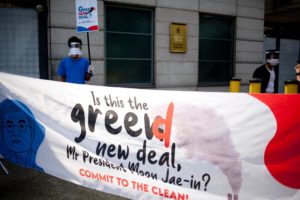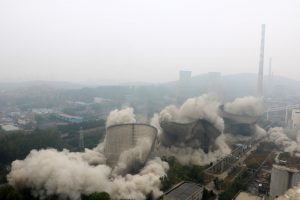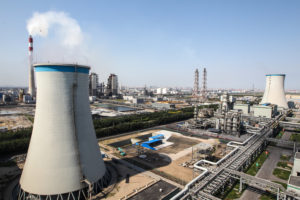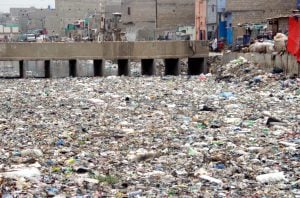The “Green New Deal” has become a hot button in South Korea. To cope with the economic damage caused by Covid-19 as well as the climate emergency, “Green New Deal” policies have been intensely debated and will soon be implemented. But the concept and its content remain a battleground. To some, it’s enough for it to be an updated version of “Low-carbon Green Growth” implemented by ex-president Lee Myung-Bak in 2008. To others, it’s an opportunity to transform South Korea’s economy and society that the country can’t afford to miss. Considering South Korea’s disappointing record on climate action, the future prospects of a “Green New Deal” may seem dim. However, civil society is actively engaging in public discussion to argue for a “People’s version of the Green New Deal” which could better equip South Korea for its fight against climate emergency and social inequality.
A hesitating proposal
During South Korea’s parliamentary election in mid-April, which was the world’s first national election amid the pandemic, the ruling centrist Democratic Party of Korea (DPK), the centre-right Party for People’s Livelihoods (PPL), the centre-left Justice Party (JP) and the left Green Party Korea (GPK) all made pledges around a “Green New Deal”.
The idea stems from Franklin D. Roosevelt’s New Deal, a series of massive government interventions to salvage the United States from the Great Depression. It has been gaining traction in the US since late 2018. At that time, Democratic members of the congress tabled a Green New Deal proposal to drastically decarbonise the economy with massive public spending, while providing millions of green jobs to underprivileged Americans. Early this year, the European Union launched its “European Green Deal”, aiming to achieve carbon neutrality in the bloc by 2050. Both are bold undertakings, comparable to the Apollo programme to land people on the moon, and strive for a just transition. The Korean parties who vied for the presidency and parliamentary seats are believed to have drawn inspiration from both.
DPK’s climate manifesto, published in March, explicitly referred to these two plans in the US and Europe, and promised to pass a “Green New Deal Special Act” to steer the country’s transformation to a low-carbon economy and to realise a “carbon zero society” in 2050.
The PPL announced it would reduce the amount of fine dust and greenhouse gas pollution by 50%, through a “10-Year Green Economy New Deal Project”, and also enact “the Climate Crisis Response Act” and create one million environmental jobs.
The JP pledged to withdraw coal-power generation and ban automobiles with internal combustion engines by 2030, to convert public transportation into electric vehicles, to carry out green renovation of one million houses, and to ensure net-zero emissions for newly built public rental homes.
The GPK proposed to achieve a 50% reduction of greenhouse gas emissions by 2030 and net-zero emissions by 2050. To achieve that, it proposed a carbon budget (of allowable emissions) and a greenhouse gas emissions impact assessment system. It also aimed for fairness during this transition by providing a universal basic income and forming a just transition committee to oversee the process.
DPK won the election by a landslide. Given its dominance in parliament, expectations for implementing the Green New Deal policies were high. South Korea was acclaimed as “the first country in East Asia to pledge to reach net zero emissions by 2050”. Yet the response of the government has since been passive and slow.
On 7 May, the government announced a “Korean version of the New Deal” as part of its Innovative Growth Policy. It contains three major tasks: “building digital infrastructure,” “cultivating non-face-to-face industries” and “digitising social overhead capital.” According to the announcement, building digital infrastructure will help industries that utilise and process data to create more jobs. Fostering “non-face-to-face industries” is a reaction to the Covid-19 pandemic, with examples including telemedicine, distance education and cyber security using blockchain. While digitising social overhead capital refers to managing old roads and railroads electronically, expanding advanced logistics centres and building road data to be used by autonomous vehicles in the future.
There is no solid consensus about the definition of ‘Green New Deal’ between the government and civil society, much less its approach.
In response to the announcement, members of civil society – environmental NGOs, the Korean Confederation of Trade Unions, and the Green Party Korea criticised the “Korean version of the New Deal” as in fact a major stimulus package for large corporations, and merely an expansion of the Innovative Growth Policy presented by the administration in its previous term. Even the former co-chair of the Platform Party, a satellite party of DPK, Professor Choi Bae-Geun (최배근), told KBS News that the real challenge for the Korean economy is to create a new industry and a new economic structure to replace the existing manufacturing industry and lead to stable growth. He thinks “the Korean version of the New Deal” seems to be just a new investment plan without considering measures of relief, reform and recovery, the key elements of Roosevelt’s New Deal.
Things changed on 13 May when a spokesperson for the Blue House said President Moon Jae-in had asked some ministries to examine the possibility of including a “Green New Deal” in the Korean version of the New Deal. On 20 May, the spokesperson confirmed that the Green New Deal would be included in the framework of the “Korean version of the New Deal”.
US$22 billion
The predicted total budget for the Korean ‘Green New Deal’ by 2025
As of 10 June, the government’s third supplementary budget of the year set aside US$30 billion, out of which the Korean version of the New Deal takes around US$4.2 billion. The government included several projects under the name of “Green New Deal”, such as improving energy efficiency in infrastructure, establishing innovative ecosystem for green industries, developing low-carbon and distributed energy systems, and retrofitting old public buildings for energy saving. The total budget for the Green New Deal is around US$1.1 billion for 2020, and will amount to around US$22 billion by 2025.
The comprehensive plan for the Green New Deal will be issued in early July. But there are great uncertainties about the scope and ambition of the plan, because there is no solid consensus about the definition of “Green New Deal” between the government and the civil society, much less its approach.
This is evident in the response of key civil society actors to the government’s proposal. Climate Strike, a coalition of 377 NGOs, the Korean Confederation of Trade Unions, and political parties like the Green Party Korea and the Justice Party all said the proposal has no big difference from the Low-carbon Green Growth strategy of 12 years ago. In fact, on 13 May, when a reporter asked a Blue House spokesperson the meaning of the “Green New Deal”, he replied it was an updated and modified version of Green Growth.
The government’s poor green records
This older version of Green New Deal was proposed by ex-president Lee Myung-Bak as a tool for his Low-carbon Green Growth strategy in 2008, when the recession hit. At that time, the Green New Deal was proposed as a means to achieve economic growth and environmental conservation simultaneously, through both technological solutions and fostering environmentally friendly industries, including renewable energies. However, the so-called Green Growth was criticised by civil society as greenwashing, because it featured construction-oriented schemes like more nuclear power plants and the Four Major Rivers Restoration Project. That project in fact saw 16 large dams built in the middle of the four rivers. These created huge algal blooms, even in the upper reaches of the rivers, and had limited capacity to control flooding in spite of an investment of around US$3 billion. Thus, the 2008 Green New Deal was not regarded as “green” by the environmental community, despite there being some attractive policies in it, including ones for reducing greenhouse gas emissions and expanding renewable energy.
In the successive administrations of Park Geun-hye, Hwang Kyo-ahn and even Moon Jae-in, environmental issues did not receive much attention. So, what has revived the public conversation about a Green New Deal in South Korea after 12 years?
The roadmap for emissions reduction proposed by South Korea is too naïve and complacent.
Heated public discussions about the concept in the US and Europe have certainly contributed. But much of it, especially from the political and economic elites, has grown out of the pressing need to overcome the economic recession caused by the pandemic. This despite South Korea being more successful in containing the virus than many other countries. Meanwhile, calls for “alternative development” from trade unions, environmental NGOs and political parties like the Green Party Korea have been mounting. Most of all, South Korea’s international image as a “climate villain” has intensified a sense that action must be taken. In 2016, Climate Action Tracker, an independent initiative by international NGOs, announced a short list of “climate villains”. South Korea led the list followed by Saudi Arabia, Australia and New Zealand.
However, apart from having different views of Green New Deal from the government, civil society also doubts its will and ability to implement the deal amid tough resistance from vested interests, in particular the conglomerates that have stranded assets in fossil fuel related industries.
In fact, in South Korea we can barely stop the despotism of conglomerates. For example, the current government allowed US$1 billion to bail out Doosan Heavy Industry Company, a failing coal power developer, without demanding the company invest the money in greener business opportunities than coal power. On the contrary, the government is supporting the export of coal power plants by Doosan and Korea Electric Power Corporation to Indonesia and Vietnam with its approval of a preliminary feasibility study. Will the Korean government exert strong climate regulation on the conglomerates? The answer might be negative.
6.5%
The proportion of South Korea’s energy mix made up of ‘new and renewable energy’
South Korea’s climate policies have also been disappointing. Its share of coal-fired power generation is 40.4%, while that of new and renewable energy (such as solar, wind, landfill gas, and by-product gas) was just 6.5% in 2019, according to The Statistics of Korea Electric Power Corporation of 2020.
To achieve the government’s goals, it’s necessary to make drastic and fundamental reforms. But will they be possible? Except for a slight decrease in 2014, South Korea’s greenhouse gas emissions have been rising continuously for the last decade. According to the “2030 GHG Reduction Roadmap” the government unveiled in 2018, on a business-as-usual pathway emissions expected to be around 850 million tons in 2030, and the goal was to reduce that by 35% to 536 million tons. However, the IPCC Special Report on Global Warming of 1.5°C, published in 2018, states that to align itself with the goal of limiting warming to the 1.5°C set in the Paris Agreement, South Korea must release no more than 340 million tons of CO2 equivalent by 2030. Considering this, it can be said that the roadmap for emissions reduction proposed by South Korea is too naïve and complacent. Earlier this year, the Global Climate Change Performance Index ranked South Korea 58th out of 61 countries. And Climate Action Tracker estimated that Korea’s target for reducing its emissions is insufficient and passive. They suggested it is necessary to raise the ambition to more than twice the current level to meet the terms of the Paris Agreement. Actually, in February 2020, the central government revealed the first draft of the Long-term Low Emission Development Strategy (LT-LEDS) of South Korea. Every party to the Paris Agreement is required to submit an LT-LEDS by the end of this year, and it should include concrete and practical roadmaps and measures regarding how to reduce emissions. However, surprisingly enough, there is no goal of net zero emissions by 2050 in South Korea’s draft LT-LEDS. Before this coming September, South Korea should set a new emissions reduction target.
In spite of gloomy expectations, local governments have started to engage in the pursuit of the Green New Deal. On 5 June, World Environment Day, 226 leaders of local governments joined a Declaration on Climate Emergency. Hongjang Kim (김홍장), mayor of Dangjin City and chairperson of the Local Government Association for Climate & Energy Transition emphasised that local government should play a leading role in responding to the global climate crisis. The Declaration asks the central government and the parliament to set a goal of “net zero emission in 2050”. It also aims to push the central government to submit a more ambitious LT-LEDS. In addition, Seoul metropolitan area and Chungnam province both decided to inject big funds into their own style of “Green New Deal project”. Seoul’s plan includes new hydrogen bus charging stations, 124 additional electric city buses, green remodelling of public buildings, support for the expansion of “urban forests”, and the decarbonisation of industries and the economy.
A project of social transformation
To realise a Green New Deal that breaks loose from the obsession with growth, strong intervention from civil society is vital. Unfortunately, civil society is not as strong in South Korea as it used to be, with many of its leaders having entered the government and public sector.
Yet civil society does have an emerging consensus on the goal of a Green New Deal. Mainly, it argues that the deal should fix social inequality and cope with the climate crisis by overhauling the existing social and economic structure. For example, Sang-Hyun Kim (김상현) at Hanyang University, who joined a declaration by the international “De-growth” movement, insists that the principle should be adopted by a Green New Deal. De-growth aims to achieve a society in which everyone’s well-being is ensured, regardless of economic growth. It argues that life should be at the centre of the economic system. Production using fossil fuels should be phased out. Healthcare, education, renewable energy development, and sustainable agriculture should be fostered. To this end, a Green New Deal should be pursued to bring about an ecological, democratic and even anti-capitalist social system.
There has recently also been a lively debate about the direction of the Green New Deal among various NGOs and members of the Korean parliament. Generally speaking, most discussions concentrate on the meaning of “green” and “new deal”. The term green is not confined to environmental preservation. Rather, it emphasises economic and political restructuring for decarbonisation. While “new deal” refers to bold undertaking of the public sector to forge an inclusive and just society capable of dealing with shocks from the climate crisis. It’s hoped that with such public discussion, a “People’s version of the Green New Deal” will come about, as opposed to one dominated by big corporations.
Finally, there is not enough attention paid to rural areas in the government’s “Green New Deal” policies. Without rectifying the uneven development between urban and rural areas in South Korea, “Green New Deal” policies will have distorted and unsatisfactory outcomes. This is an aspect that civil society has also overlooked.








